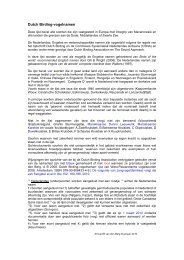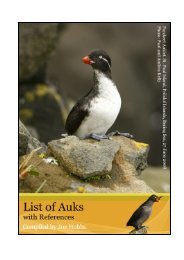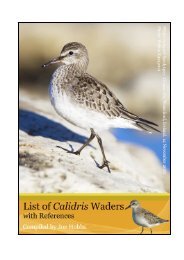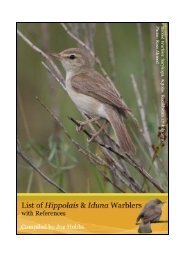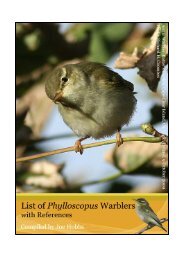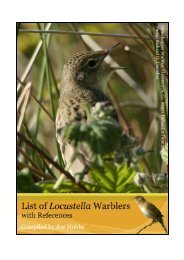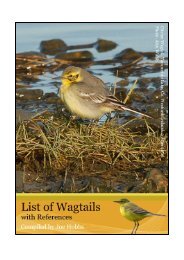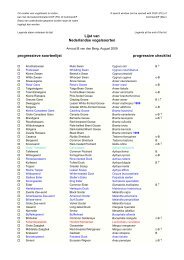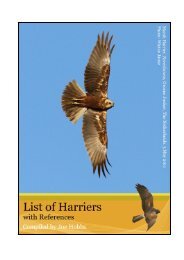Shrikes references - Irish Rare Birds Committee
Shrikes references - Irish Rare Birds Committee
Shrikes references - Irish Rare Birds Committee
You also want an ePaper? Increase the reach of your titles
YUMPU automatically turns print PDFs into web optimized ePapers that Google loves.
Mountain Shrike [Lanius validirostris] 11Newton’s Fiscal [Lanius newtoni] 18Northern Fiscal [Lanius humeralis] 18Northern Shrike [Lanius borealis] 14Red-backed Shrike [Lanius collurio] 6Red-tailed Shrike [Lanius phoenicuroides] 9Socotra Grey Shrike [Lanius uncinatus] 15Somalia Fiscal [Lanius somalicus] 18Southern Fiscal [Lanius collaris] 18Southern Grey Shrike [Lanius sp.] 15Souza’s Shrike [Lanius souzae] 4Steppe Grey Shrike [Lanius pallidirostris] 16Taita Fiscal [Lanius dorsalis] 17Tiger Shrike [Lanius tigrinus] 4Woodchat Shrike [Lanius senator] 192
Wassink, A. 1996. Izabelklauwier op Texel in mei 1995 [Isabelline Shrike on Texel in May 1995].Dutch Birding 18(3): 129-131.Wassink, A. 2009. <strong>Birds</strong> of Kazakhstan: new and interesting data, part 2. Dutch Birding 31(2): 101-110 (106 & 108).Wouters, P. 1996. Izabelklauwier op Texel in oktober 1985 [Isabelline Shrike on Texel in October1985]. Dutch Birding 18(3): 131-133.Burmese ShrikeLanius collurioides [Lesson 1831, Pegu, Myanmar].[L.c. collurioides] Extreme E India & Myanmar S to C Tenasserim Hills and W & C Yunnan E to SGuizhou & SW Guangdong (S China), NW & W Thailand, Laos, E Cambodia & N Vietnam.[L.c. nigricapillus] S Vietnam.Other name: Chestnut-rumped Shrike, Chestnut-backed Shrike.Choudhury, A. 2001. Some bird records from Nagaland, north-east India. Forktail 17: 91-103 (93).Emin’s ShrikeLanius gubernator [Hartlaub 1882, Central Africa = Langomeri, Uganda].R Niger (S Mali) & N Ivory Coast E discontinuously to S Sudan, NE DRCongo & N Uganda.Eduard Schnitzer, aka Emin Pasha (1840-1892), German explorer and administrator in Africa, wholater became a physician in Albania where he was called Emin.Walsh, F. 1968. Emin’s Bush Shrike in Borgu. Bulletin of the Nigerian Ornithologists' Society 5(17):26-27.Bay-backed ShrikeLanius vittatus [Valenciennes 1826, Pondicherry, India].[L.v. vittatus] S & E Pakistan, Kashmir, India (except N & NE) & S Nepal.[L.v. nargianus] SE Turkmenistan, SE Iran, Afghanistan & Pakistan.Kylänpää, J. 2000. <strong>Birds</strong> of Dera Ismail Khan District of North West Frontier Province in Pakistan.Forktail 16: 15-28 (23).Long-tailed ShrikeLanius schach [Linnaeus 1758, Canton area, Guangdong, SE China].[L.s. schach] C, S & SE China (including Hainan), Taiwan and Tonkin & Annam (N Vietnam).[L.s. erythronotus] SE Kazakhstan, S Uzbekistan, Kyrgyzstan, S Turkmenistan, Tajikistan,Afghanistan & Pakistan (except SW) E to N & NC India and probably NE Iran. Winters, C Asia & NPakistan pops. move SE to India.[L.s. caniceps] NC & peninsular India & N Sri Lanka.[L.s. tricolor] Nepal & E India E to Myanmar, S Xizang & Yunnan (S China), N Laos & N Thailand.[L.s. longicaudatus] C, SE & S Thailand & S Laos and possibly Tenasserim (S Myanmar).[L.s. bentet] S Malay peninsula, Sumatra, Java, SE Borneo & Lesser Sunda Islands E to Timor.[L.s. nasutus] Philippines (except Palawan and Sulu Island).[L.s. suluensis] Jolo (Sulu Archipelago, SW S Philippines).[L.s. stresemanni] Huon peninsula and adjacent hinterland (NE New Guinea).Other names: Black-headed Shrike, Black-capped Shrike, Schach Shrike, Rufous-backed Shrike,Rufous-rumped Shrike, Large-nosed Shrike (nasutus), Dusky Shrike (melanistic variant).1st WP Record: [adult ♂] November 1982. Sede Boqer, near Yeroham, Israel. Remained untilFebruary 1983 (Shirihai, H. 1996. The <strong>Birds</strong> of Israel. Academic Press).Biswas, B. 1950. On the shrike Lanius tephronotus (Vigors) with remarks on the erythronotus andtricolor groups of Lanius schach Linné and their hybrids. Journal of the Bombay Natural HistorySociety 49: 444-455.Biswas, B. 1962. Further notes on the shrikes Lanius tephronotus and Lanius schach. Ibis 140(1):112-115.Dufourny, H. 2006. First record of Long-tailed Shrike Lanius Schach for Jordan. Sandgrouse 28(1):73-76.10
Evans, T.D. & Timmins, R.J. 1998. Records of birds from Laos during January-July 1994. Forktail13: 69-96 (76).Fågel, P. 2007. Kuwait - A Birding Destination at the Southeastern Corner of the Western Palearctic.Alula 13(4): 166-174 (172, photo 17).Fuchs, J. et al 2007. <strong>Birds</strong> of Phongsaly province and the Nam Ou river, Laos. Forktail 23: 22-86(36).Gantlett, G. 2006. In search of a tragopan: birding Bhutan. Birding World 19(7): 293 (plate 28, 306).Kylänpää, J. 2000. <strong>Birds</strong> of Dera Ismail Khan District of North West Frontier Province in Pakistan.Forktail 16: 15-28 (23).Nikolov, B.P. et al 2006. Abnormally plumaged Woodchat <strong>Shrikes</strong> in Bulgaria, with notes on albinoand aberrantly pale Laniidae worldwide. Dutch Birding 28(2): 90-95 (93).Rabbitts, B. 2001. Reports (Another British first for desolate island group). Birdwatch 103: 50-51.Robson, C. & Davidson, P. 1995. Some recent records of Philippine birds. Forktail 11: 162-167 (165& 166).Roselaar, C.S. & Aliabadian, M. 2009. Review of rare birds in Iran, 1860s-1960s. Podoces 4(1): 1-27 (16).Shirihai, H. & Golan, Y. 1994. First records of Long-tailed Shrike Lanius schach in Israel and Turkey.Sandgrouse 16(1): 36-40.Stevenson, A. 2000. The Long-tailed Shrike on the Outer Hebrides - a new British bird. Birding World13(11): 454-457.Stevenson, A. 2005. Long-tailed Shrike: new to Britain. British <strong>Birds</strong> 98(1): 26-31.van der Spek, V. & Valkenburg, M. 2010. Birding in Kyrgyzstan. Dutch Birding 32(1): 10-20 (plate13, 13).van Dillen-Staal, J. & Ebels, E.B. 2012. Langstaartklauwier bij Den Helder in oktober 2011 [LongtailedShrike near Den Helder in October 2011]. Dutch Birding 34(5): 305-309.Wassink, A. & Oreel, G.J. 2008. <strong>Birds</strong> of Kazakhstan: new and interesting data. Dutch Birding 30(2):93-100 (99).Wassink, A. 2013. <strong>Birds</strong> of Kazakhstan: new and interesting data, part 4. Dutch Birding 35(1): 30-34(31).Grey-backed ShrikeLanius tephronotus [Vigors 1831, Himalayas = near Darjeeling, India].[L.t. tephronotus] Nepal E to Arunachal Pradesh (NE India) and S Gansu, Ningxia & E Shaanxi S toSE Qinghai, S & E Xizang, SE Yunnan & C Guizhou (C & S China). Winters S to Bangladesh,Myanmar, Thailand & Indochina.[L.t. lahulensis] N Kashmir E to Uttaranchal Pradesh (CN India) and probably W Xizang (SW China).Other name: Tibetan Shrike.Biswas, B. 1950. On the shrike Lanius tephronotus (Vigors) with remarks on the erythronotus andtricolor groups of Lanius schach Linné and their hybrids. Journal of the Bombay Natural HistorySociety 49: 444-455.Biswas, B. 1962. Further notes on the shrikes Lanius tephronotus and Lanius schach. Ibis 140(1):112-115.Newton, P.A. 2002. Bird records from the Siang River valley, Arunachal Pradesh, India. Forktail 18:156-157.Tryjanowski, P. & Reino, L.M. 2004. Post-breeding habitat selection of the Grey-backed ShrikeLanius tephronotus in Sichuan, China. Biological Letters 41: 193-195.Mountain ShrikeLanius validirostris [Ogilvie-Grant 1894, mountains of N Luzon, Philippines].[L.v. validirostris] Cordillera & N Sierra Madre (N Luzon, N Philippines).[L.v. tertius] Mt Halcon & Mt Dulungan (N Mindoro, NC Philippines).[L.v. hachisuka] Mt Malindang, mountains of Misamis Oriental, Mt Kitanglad & Civolig, Mt Apo(Mindanao, S Philippines).The proposed form quartus is included with L.v. hachisuka.Other names: Philippine Shrike, Strong-billed Shrike, Grey-capped Shrike.Dutson, G.C.L. et al 1992. Conservation status of birds on Mindoro, Philippines. Bird ConservationInternational 2: 303-325 (313).11
Mackinnon’s ShrikeLanius mackinnoni [Sharpe 1891, Kikuyu (= Bugemaia, Kavirondo), Kenya].Obodu Plateau (SE Nigeria) & SW Cameroon S to S PR Congo, NW Angola & N DR Congo E toextreme W Kenya and S to SW Uganda, W Rwanda, Burundi and NW & N Tanzania.Other names: Mackinnon’s Fiscal, Mackinnon’s Grey Shrike.Archibald Donald Mackinnon CMG OBE (1864-1937), Scottish medical doctor who worked in Uganda.Bowden, C.G. 2001. The birds of Mount Kupe, southwest Cameroon. Malimbus 23: 13-44 (37).Fuchs, J. et al 2011. Phylogeography of the fiscal shrike (Lanius collaris): a novel pattern of geneticstructure across the arid zones and savannas of Africa. Journal of Biogeography 38(11): 2210-2222.Lesser Grey ShrikeLanius minor [J.F. Gmelin 1788, Italy, Spain, Russia = Italy].Spain E thru Italy, Balkans, Turkey, European Russia to W Siberia and S to Iran & C Asia. WintersAngola, Namibia, Botswana & South Africa.Treated by del Hoyo et al 2008 to be polytypic with races minor & turanicus.Collinson, M. 2006. Splitting headaches? Recent taxonomic changes affecting the British andWestern Palearctic lists. British <strong>Birds</strong> 99(6): 306-323 (317).de Roos, J.A. 1994. Letters (<strong>Shrikes</strong> pursuing orher birds). British <strong>Birds</strong> 87(5): 237.Dowsett, R.J. 1971. The Lesser Grey Shrike Lanius minor in Africa. Ostrich 42(4): 259-270.Giralt, D. & Valera, F. 2007. Population trends and spatial synchrony in peripheral populations of theendangered Lesser grey shrike in response to environmental change. Biodiversity andConservation 16(4): 841-856.Giralt, D. et al 2008. The role of natural habitats in agricultural systems for bird conservation: thecase of the threatened Lesser Grey Shrike. Biodiversity and Conservation 17(8): 1997-2012.Herremans, M. 1998. Monitoring the world population of the Lesser Grey Shrike (Lanius minor) onthe non-breeding grounds in southern Africa. Journal für Ornithologie 139(4): 485-493.Hoi, H. et al 2004. Clutch enlargement in Lesser Gray <strong>Shrikes</strong> (Lanius minor) in Slovakia when foodis superabundant: A maladaptive response? The Auk 121(2): 557-564.Isenmann, P. & Debout, G. 2000. Vineyards harbour a relict population of Lesser Grey Shrike(Lanius minor) in Mediterranean France. Journal für Ornithologie 141(4): 435-440.Kristin, A. 1995. Why the Lesser Gray Shrike (Lanius minor) survives in Slovakia: Food and habitatp<strong>references</strong>, breeding biology. Folia Zoologica 44: 325-334.Kristin, A. et al 2000. Breeding biology and breeding success of the Lesser Grey Shrike (Laniusminor) in a stable and dense population. Ibis 142: 305-311.Kvist, L. et al 2011. Population decline is accompanied by loss of genetic diversity in the Lesser GreyShrike Lanius minor. Ibis 153(1): 98-109.Lack, P.C. 1986. Ecological correlates of migrants and residents in a tropical African savanna. Ardea74: 111-119.Lovászi, P. et al 2000. Nest-site selection and breeding success of the Lesser Grey Shrike (Laniusminor) in Hungary. The Ring 22(1): 157-164.Lovatt, J. 1992. Lesser Grey Shrike in Co. Wexford. <strong>Irish</strong> Birding News 2(4): 120-121.Martins, R.P. et al 1996. The status of passerines in southern Yemen and records of the OSMEsurvey in spring 1993. Sandgrouse 17: 54-72 (66).Mason, N. 2006. Reports (A Shingle treat. Lesser Grey Shrike: Shingle Street, Suffolk, 8-11 July2006). Birdwatch 171: 58-59.Moga, C.I. et al 2010. Habitat use by the endangered Lesser Grey Shrike Lanius minor in CentralRomania. Belgian Journal of Zoology 140(2): 225-228.Nikolov, B. 2003. Notes ( Presumed hybrid between Red-backed Shrike and Lesser Grey Shrike inBulgaria. British <strong>Birds</strong> 96(9): 455-456.Odell, D. 1990. Mystery photographs (Lesser Grey Shrike). British <strong>Birds</strong> 83(8): 330-331.Valera, F. et al 2001. Why does the Lesser Grey Shrike (Lanius minor) seldom store food?Determinants of impaling in an uncommon storing species. Behaviour 138: 1421-1436.van Bemmelen, R.S.A. & Groenendijk, D. 2006. Masters of Mystery Solutions of third round 2006(Lesser Grey Shrike). Dutch Birding 28(4): 239.Vinicombe, K. 2009. Identification (Grey <strong>Shrikes</strong>). Birdwatch 208: 28-30.Wirtitsch, M. et al 2001. Habitat composition and use in the Lesser Grey Shrike Lanius minor. FoliaZoologica 50:137-150.12
Loggerhead ShrikeLanius ludovicianus [Linnaeus 1766, Louisiana, USA].[L.l. ludovicianus] North Carolina E of Appalachian Mts. S to Gulf Coast states & S tip of Florida.[L.l. migrans] S Ontario, S Quebec & S Michigan and E edge of Great Plains E to New York & Atlanticcoast and S into Mississippi Valley to N Mississippi, Arkansas & N Louisiana. Winters in S of rangeand S to Gulf Coast states & E coast of Mexico.[L.l. excubitorides] S British Columbia, C Alberta, S Saskatchewan & SW Manitoba S to EWashington, extreme S Oregon, S Idaho, California, Arizona, New Mexico & Texas (except NE) andE to North Dakota, South Dakota, Nebraska, Kansas & W Oklahoma. Winters in S parts of range andS to W Mexico including Baja California.[L.l. miamensis] Cutler (Miami-Dade County, SE Florida).[L.l. anthonyi] Santa Rosa, Santa Cruz & Santa Catalina (Channel Islands, off S California).[L.l. mearnsi] San Clemente Island (off S California).[L.l. grinnelli] Extreme S California S to C Baja California Norte (extreme NW Mexico).[L.l. mexicanus] W & C Mexico (including S Baja California) S to Oaxaca.Anderson, W.L. & Duzan, R.E. 1978. DDE residues and eggshell thinning in Loggerhead<strong>Shrikes</strong>. The Wilson Bulletin 90(2): 215-220.Bohall-Wood, P. 1987. Abundance, habitat use, and perch use of Loggerhead <strong>Shrikes</strong> in northcentralFlorida. The Wilson Bulletin 99(1): 82-86.Brooks, B.L. & Temple, S.A. 1990. Dynamics of a Loggerhead Shrike population in Minnesota. TheWilson Bulletin 102(3): 441-450.Brooks, B.L. & Temple, S.A. 1990. Habitat availability and suitability for Loggerhead <strong>Shrikes</strong> in theupper Midwest. American Midland Naturalist 123(1): 75-83.Cade T. 1992. Hand-Reared Loggerhead <strong>Shrikes</strong> Breed in Captivity. The Condor 94(4): 1027-1029.Cade, T.J. & Woods, C.P. 1997. Changes in distribution and abundance of the LoggerheadShrike. Conservation Biology 11(1): 21-31.Craig, R.B. 1978. An analysis of the predatory behavior of the Loggerhead Shrike. The Auk 95(2):221-234.Ericsson, S. 1981. Loggerhead Shrike in Guatemala in December 1979. Dutch Birding 3(1): 27-28.Esely, J.D. & Bollinger, K. 2003. Patterns of impaling in a migratory population of the LoggerheadShrike. The Prairie Naturalist 35(1): 1-8.Gawlik, D.E. & Bildstein, K.L. 1990. Reproductive success and nesting habitat of Loggerhead<strong>Shrikes</strong> in north-central South Carolina. The Wilson Bulletin 102(1): 37-48.Kaufman, K. 1994. Answers to the October Photo Quiz (Loggerhead Shrike). Birding XXVI(6): 430-431.Kridelbaugh, A. 1983. Nesting ecology of the Loggerhead Shrike in central Missouri. The WilsonBulletin 95(2): 303-308.Mundy N.I. et al 1997. Genetic differences between the endangered San Clemente Island loggerheadshrike Lanius ludovicianus mearnsi and two neighbouring subspecies demonstrated by mtDNAcontrol region and cytochrome b sequence variation. Molecular Ecology 6(1): 29-37.Mundy N.I. et al 1997. Microsatellite variation and microevolution in the critically endangered SanClemente Island loggerhead shrike (Lanius ludovicianus mearnsi). Proceedings of the RoyalSociety of London - Series B 264(1383): 869-875.Nikolov, B.P. et al 2006. Abnormally plumaged Woodchat <strong>Shrikes</strong> in Bulgaria, with notes on albinoand aberrantly pale Laniidae worldwide. Dutch Birding 28(2): 90-95 (94).Porter, D.K. et al 1975. Nest ecology, productivity, and growth of the Loggerhead Shrike on theshortgrass prairie. The Southwestern Naturalist 19(4): 429-436.Tyler, J.D. 1992. Nesting ecology of the Loggerhead Shrike in southwestern Oklahoma. The WilsonBulletin 104(1): 95-104.Yosef, R. & Grubb Jr., T.C. 1992. Territory size influences nutritional condition in nonbreedingLoggerhead <strong>Shrikes</strong> (Lanius ludovicianus): a ptilochronology approach. Conservation Biology 6:447-449.Yosef, R. & Grubb Jr, T.C. 1993. Effect of vegetation height on hunting behavior and diet ofLoggerhead <strong>Shrikes</strong>. The Condor 95(1): 127-131.Yosef, R. & Grubb Jr., T.C. 1994. Resource dependence and territory size in Loggerhead <strong>Shrikes</strong>(Lanius ludovicianus). The Auk 111(2): 465-469.Yosef, R. 1994. The effects of fencelines on the reproductive success of Loggerhead <strong>Shrikes</strong>.Conservation Biology 8(1): 281-285.13
Great Grey ShrikeGreat Grey ShrikeLanius excubitor [Linnaeus 1758, Europe = Sweden].[L.e. excubitor] N, C & NE Europe E to NW Siberia and S to S Russia. Winters S Scandinavia, Britainand W & S France E to Asia Minor, Caucasus & Transcaspia.[L.e. homeyeri] E Balkans, Bulgaria, S Romania, Ukraine E to foothills of S Urals and SW Siberia E toN foothills of Altai. Winters SW & C Asia.Other name: Steppe Shrike (homeyeri).Northern ShrikeLanius borealis [Vieillot 1808].[L.b. borealis] N Ontario and N & C Quebec E to Labrador. Winters SE Canada and C & E USA.[L.b. bianchii] Sakhalin Island & S Kuril Islands. Winters Hokkaido (N Japan).[L.b. funereus] Dzhungarian Alatau Mts (E Kazakhstan) and S & E Tien Shan (Kyrgystan-NW Chinaborder region).[L.b. mollis] Altai & Sayan Mts (CS Russia) & NW Mongolia. Winters S to N China.[L.b. sibiricus] C & E Siberia E to Kolyma Basin, Anadyrland & Chukotsk peninsula and S to L Baikal,N Mongolia & N Amurland (SE Russia) and possibly Paramushir Island (N Kuril Islands). Winters SCSiberia, Mongolia, NE China & Ussuriland.Treated by del Hoyo et al 2008 as races of Great Grey Shrike.Other names: North Siberian Shrike (sibiricus), Altai Shrike (mollis).Callahan, D. 2011. Speciation (The spice of life). Birdwatch 231: 44-47.Callahan, D. 2011. Species profile (Grey matters). Birdwatch 232: 44-47.Clement, P. & Worfolk, T. 1995. Letters (More Great Grey <strong>Shrikes</strong>). Birding World 8(11): 429.Clement, P. & Worfolk, T. 1995. Southern and eastern Great Grey <strong>Shrikes</strong> in northwest Europe.Birding World 8(8): 300-309.Collinson, M. 2006. Splitting headaches? Recent taxonomic changes affecting the British andWestern Palearctic lists. British <strong>Birds</strong> 99(6): 306-323 (323).Eyre Dickinson, J.C. 1992. Notes (Great Grey Shrike eating hawthorn berries). British <strong>Birds</strong> 85(6):315.Francis, M. 1983. Notes (Great Grey Shrike pellet analysis). British <strong>Birds</strong> 76(10): 458.Hromada, M. et al 2002. Presence of the Great Grey Shrike Lanius excubitor affects breedingpasserine assemblage. Annales Zoologici Fennici 39: 125-130.Hromada, M. et al 2003. Animals of different phenotype differentially utilise dietaryniche — the caseof the Great Grey Shrike Lanius excubitor. Ornis Fennica 80(1): 1-8.Janni, O. et al 2001. An interesting grey shrike in Italy. Birding World 14(4): 170-171.Kramer, D. 1985. Notes (Call of Great Grey Shrike). British <strong>Birds</strong> 78(1): 49.Lefranc, N. 1997. Identification (Grey Matters). Birdwatch 66: 23-30.Lefranc, N. 1998. Letters (More grey matter). Birdwatch 68: 16-17.Lorek, G. 1996. Notes (Great Grey Shrike eating Red-backed Shrike). British <strong>Birds</strong> 89(10): 456-457.Lorek, G. et al 2000. <strong>Birds</strong> as prey of the Great Grey Shrike (Lanius excubitor). The Ring 22(1): 37-44.Nikolov, B.P. et al 2004. Diet composition and spacial patterns of food catching in wintering GreatGrey <strong>Shrikes</strong> (Lanius excubitor) in Bulgaria. Biological Letters 41: 119-133.Nikolov, B.P. et al 2006. Abnormally plumaged Woodchat <strong>Shrikes</strong> in Bulgaria, with notes on albinoand aberrantly pale Laniidae worldwide. Dutch Birding 28(2): 90-95 (93).Olsson, U. et al 2010. The Lanius excubitor (Aves, Passeriformes) conundrum - Taxonomic dilemmawhen molecular and non-molecular data tell different stories. Molecular Phylogenetics andEvolution 55: 347–357.Perttula, P. & Tenovuo, J. 2002. Great Grey Shrike subspecies excubitor, sibiricus and borealis.Alula 8(2): 54-60.Poelstra, J. 2010. Trends in systematics - Speciation in shades of grey: the great grey shrikecomplex. Dutch Birding 32(4): 258-264.Probst, R. 2002. Notes (Great Grey Shrike feeding on carrion). British <strong>Birds</strong> 95(1): 25.Probst, R. et al 2002. UV reflecting vole scent marks attract a passerine, the great grey shrike Laniusexcubitor. Journal of Avian Biology 33(4): 437-440.Rowlands, A. 2011. The Carl Zeiss Award (Great Grey Shrike, perhaps L.e. homeyeri, Blacka Moor,hathersage, Yorkshire, November 2010). British <strong>Birds</strong> 104(8): 462-465.14
Sachslehner, L. et al 2004. The breeding population of the Great Grey Shrike (Lanius excubitor) inAustria. Biological Letters 41: 135-146.Svennson, L 1988. Letters (Confusing shrikes). Birdwatch 68: 16.Tenovuo, J. & Varrela, J. 1998. Identification of the Great Grey Shrike complex in Europe. Alula 4(1):2-11.Tryjanowski, P. & Hromada, M. 2004. Do males of the great grey shrike, Lanius excubitor trade foodfor extrapair copulations? Animal Behaviour 69: 529-533.Tryjanowski, P. & Lorek, G. 1998. Notes (Common Kestrels and great Grey Shrike hunting insectsby artificial light). British <strong>Birds</strong> 91(8): 327.Vinicombe, K. 2009. Identification (Grey <strong>Shrikes</strong>). Birdwatch 208: 28-30.Southern Grey ShrikeDesert Grey ShrikeLanius elegans [Swainson 1832].[L.e. elegans] NE Mauritania, NW Mali & S Tunisia E to C & S Libya, Egypt including Sinai peninsula,SW Israel & NE Sudan S to Port Sudan and possibly NE Niger.[L.e. leucopygos] C & S Mauritania, C Mali, C & S Niger, NE Nigeria and probably extreme NCameroon, S Chad, C Sudan & Darfur.[L.e. algeriensis] NW Africa along Atlantic & Mediterranean coasts E to N Tunisia & N Libya and S tocoastal NW Mauritania & N Sahara.[L.e. koenigi] Canary Islands.Treated by del Hoyo et al 2008 as races of Southern Grey Shrike.Iberian Grey ShrikeLanius meridionalis [Temminck 1820, Provence, France].Iberian peninsula & S France.Treated by del Hoyo et al 2008 as the nominate race of polytypic Southern Grey Shrike.Socotra Grey ShrikeLanius uncinatus [P.L. Sclater & Hartlaub 1881].Socotra.Treated by del Hoyo et al 2008 as a race of Southern Grey Shrike.Asian Grey ShrikeLanius lahtora [Sykes 1832].[L.l. lahtora] Pakistan (except N) & foothills of Himalayas in N India S to Karnataka and E to CBangladesh.[L.l. buryi] Yemen.[L.l. aucheri] CE Sudan S from Port Sudan, Eritrea, N Ethiopia, NW Somalia, Iraq, S Iran, Syria, SLebanon, Israel, SE Sinai peninsula, W Arabian peninsula & Oman.The proposed forms jebelmarrae & theresae are included with L.l. aucheri.Treated by del Hoyo et al 2008 as races of Southern Grey Shrike.Callahan, D. 2011. Speciation (The spice of life). Birdwatch 231: 44-47.Callahan, D. 2011. Species profile (Grey matters). Birdwatch 232: 44-47.Campos, F. & Martín, R. 2010. Spatial and temporal distribution of Southern Grey <strong>Shrikes</strong> Laniusmeridionalis in agricultural areas. Bird Study 57(1): 84-88.Carrascal, L.M. et al 2008. Bias in density estimations using strip transects in dry open-countryenvironments in the Canary Islands. Animal Biodiversity and Conservation 31(2): 45-50.Clement, P. & Worfolk, T. 1995. Letters (More Great Grey <strong>Shrikes</strong>). Birding World 8(11): 429.Clement, P. & Worfolk, T. 1995. Southern and eastern Great Grey <strong>Shrikes</strong> in northwest Europe.Birding World 8(8): 300-309.Collinson, M. 2006. Splitting headaches? Recent taxonomic changes affecting the British andWestern Palearctic lists. British <strong>Birds</strong> 99(6): 306-323 (323).Forrester, R.W. 1998. Amendments to the Scottish List. Scottish <strong>Birds</strong> 19(5): 259-261 (260).García-del-Rey, E. 2005. Density estimates of passerine bird species in Tenerifean coastal scrubusing two different methods (Canary Islands). Vieraea 33: 193-199.Gonzalez, J. et al 2008. Evidence from DNA nucleotide sequences and ISSR profiles indicatesparaphyly in subspecies of the Southern Grey Shrike (Lanius meridionalis). Journal of Ornithology149(4): 495-506.Janni, O. et al 2001. An interesting grey shrike in Italy. Birding World 14(4): 170-171.15
Jiguet, F. 2003. Southern Grey <strong>Shrikes</strong> in Tunisia and a potential pitfall for Steppe Grey Shrike.Birding World 16(8): 340-341.Kirwin, G.M. 2007. Studies of Socotran birds IV. Synonymization of six endemic bird taxa, withcomments on the name Onychognathus blythii creaghi. Sandgrouse 29(2): 135-148 (139-140).Klassert, E.K. et al 2008. Mitochondrial DNA points to Lanius meridionalis as a polyphyletic species.Molecular Phylogenetics and Evolution 47: 1227-1231.Kylänpää, J. 2000. <strong>Birds</strong> of Dera Ismail Khan District of North West Frontier Province in Pakistan.Forktail 16: 15-28 (23).Lees, A.C. 2005. Macaronesian endemic birds: their taxonomy, status and conservation. Alula 11(1):12-24 (20).Lefranc, N. 1997. Identification (Grey Matters). Birdwatch 66: 23-30.Lefranc, N. 1998. Letters (More grey matter). Birdwatch 68: 16-17.Martins, R.P. et al 1996. The status of passerines in southern Yemen and records of the OSMEsurvey in spring 1993. Sandgrouse 17: 54-72 (66).Olsson, U. et al 2010. The Lanius excubitor (Aves, Passeriformes) conundrum - Taxonomic dilemmawhen molecular and non-molecular data tell different stories. Molecular Phylogenetics andEvolution 55: 347-357.Poelstra, J. 2010. Trends in systematics - Speciation in shades of grey: the great grey shrikecomplex. Dutch Birding 32(4): 258-264.Svennson, L 1988. Letters (Confusing shrikes). Birdwatch 68: 16.Tenovuo, J. & Varrela, J. 1998. Identification of the Great Grey Shrike complex in Europe. Alula 4(1):2-11.Steppe Grey ShrikeLanius pallidirostris [Cassin 1851].NW Caspian Sea & S Kazakhstan E to Mongolia & N China and NE Iran, Afghanistan, N Pakistan &W foothills of Tien Shan.Treated by del Hoyo et al 2008 as a race of Southern Grey Shrike.Other names: Saxaul Shrike.Ashby, V. & Annenkova, S. 2004. Birding Kazakhstan. Birding World 17(6): 242-253 (245).Bonser, R. et al 2011. Birding Kuwait. Birding World 24(11): 467-484 (plate 21, 481).Callahan, D. 2011. Species profile (Grey matters). Birdwatch 232: 44-47.Clement, P. & Worfolk, T. 1995. Letters (More Great Grey <strong>Shrikes</strong>). Birding World 8(11): 429.Clement, P. & Worfolk, T. 1995. Southern and eastern Great Grey <strong>Shrikes</strong> in northwest Europe.Birding World 8(8): 300-309.Collinson, M. 2006. Splitting headaches? Recent taxonomic changes affecting the British andWestern Palearctic lists. British <strong>Birds</strong> 99(6): 306-323 (323).Cox, S. 1996. The Steppe Grey Shrike in Essex. Birding World 9(11): 432-433.Dunn, S. 2009. Reports (Out of Steppe. Steppe Grey Shrike: Lound, Notts, 4-8 October 2009).Birdwatch 210: 54.Eds. 2010. Reports (Steppe up. Steppe Grey Shrike: Loch of Strathbeg RSPB, Aberdeenshire, 14October 2010). Birdwatch 222: 54.Fraser, M. 2004. ListCheck (Splits: Steppe Grey Shrike). Birdwatch 145: 13.Janni, O. et al 2001. An interesting grey shrike in Italy. Birding World 14(4): 170-171.Jiguet, F. 2003. Southern Grey <strong>Shrikes</strong> in Tunisia and a potential pitfall for Steppe Grey Shrike.Birding World 16(8): 340-341.Latham, A. 2012. Reports (Steppe Grey day. Steppe Grey Shrike: Wall Farm LNR, Shropshire, 28October-9 November 2011). Birdwatch 235: 70-71.Lefranc, N. 1997. Identification (Grey Matters). Birdwatch 66: 23-30.Lefranc, N. 1998. Letters (More grey matter). Birdwatch 68: 16-17.Mann, C.F. & Diskin, D.A. 1993. Northern Shrike Lanius excubitor, a species new to Borneo andSouth-East Asia. Forktail 8: 153-154.Moores, N. & Moores, C. 2004. A presumed Steppe Grey Shrike (Lanius pallidirostris)on SocheongIsland, S Korea. Biological Letters 41(2): 163-166.Moores, N. 2007. Selected records from Socheong Island, South Korea. Forktail 23: 102-124 (110).Poelstra, J. 2010. Trends in systematics - Speciation in shades of grey: the great grey shrikecomplex. Dutch Birding 32(4): 258-264.Ryan, J. 1995. From the Rarities <strong>Committee</strong>'s files: 'Steppe' Great Grey Shrike in Corwall. British<strong>Birds</strong> 88(6): 288-290.16
Svennson, L 1988. Letters (Confusing shrikes). Birdwatch 68: 16.Tarrant, S. 2008. The Steppe Grey Shrike in Lincolnshire. Birding World 21(11): 457-460.Tarrant, S. 2009. Reports (Shrike it lucky! Steppe Grey Shrike: Grainthorpe haven, Lincolnshire, 7-26November 2008). Birdwatch 199: 58-59.Tenovuo, J. & Varrela, J. 1998. Identification of the Great Grey Shrike complex in Europe. Alula 4(1):2-11 (7-9).Vinicombe, K. 1995. Identification (The ones to watch). Birdwatch 42: 24-30 (29).Vinicombe, K. 2003. Reports (One Steppe for man). Birdwatch 134: 50-51.Vinicombe, K. 2009. Identification (Grey <strong>Shrikes</strong>). Birdwatch 208: 28-30.Wassink, A. & Oreel, G.J. 2008. <strong>Birds</strong> of Kazakhstan: new and interesting data. Dutch Birding 30(2):93-100 (99).Wassink, A. 1997. Steppeklapekster op Texel in september 1994 [Steppe Grey Shrike on Texel inSeptember 1994]. Dutch Birding 19(3): 116-121.Wormwell, C. 2003. The Steppe Grey Shrike on the Isle of Man. Birding World 16(6): 248-251.Chinese Grey ShrikeLanius sphenocercus [Cabanis 1873, China].[L.s. sphenocercus] E Mongolia E to SE Russia, NE & NC China, N & C Korean peninsula. Wintersmainly E & SE China and Korea.[L.s. giganteus] C & E Qinghai, E Xizang and N & W Sichuan (C China).Other names: Chinese Great Grey Shrike, Long-tailed Grey Shrike, Wedge-tailed Shrike, LargeChinese Shrike.Lei, F-M. et al 2004. Morphology and distribution of the Chinese Grey Shrike (Lanius sphenocercus)in China. Biological Letters 41(2): 175-180.Grey-backed FiscalLanius excubitoroides [Prévost and Des Murs 1847, Abyssinia and Nubia = White Nile].[L.e. excubitoroides] Sahel zone of Mauritania and Mali, extreme NE Nigeria, N Cameroon, SW & SEChad & N Central African Republic E to DR Congo, S (but not SW) Sudan & W Uganda.[L.e. intercedens] C Ethiopia S & W from L Tana and probably extreme SE Sudan S to NE Uganda &W Kenya W of Elgeyo Escarpment.[L.e. boehmi] SC Uganda, extreme E DR Congo, E Rwanda, E Burundi, L Victoria S patchily to LMalawi (W Tanzania) & E shores of L Victoria (SW Kenya).Banage, W.B. 1969. Territorial behaviour and population in the Grey-backed Fiscal Shrike. UgandaJournal 33(2): 201-208.Crochet, P-A. & Haas, M. 2013. Western Palearctic list updates: re-evaluation of five species fromcontinental Mauritania. Dutch Birding 35(1): 28-30 (29).Zack, S. 1986. Behaviour and breeding biology of the cooperatively breeding Grey-backed FiscalShrike Lanius excubitorius in Kenya. Ibis 128(2): 214-233.Long-tailed FiscalLanius cabanisi [E.J.O. Hartert 1906, Mombasa, Kenya].S Somalia, S & SE Kenya from E of L Victoria E to the coast and NE & S Tanzania S to Kilosa & Dares Salaam and Usanga Flats (SW Tanzania).Brosset, A. 1989. Un cas d'association à bénéfice mutuel, celui de la Pie Grièche Lanius cabanisiavec les bulabornis Bulalornis niger [A mutualistic relationship between the long-tailed fiscal shrikeand red-billed buffalo weavers]. Revue d’Ecologie 44(1): 103-106.Taita FiscalLanius dorsalis [Cabanis 1878, Ndi, Teita, Kenya].Extreme SE Sudan, S Ethiopia & S Somalia (except extreme S coastal zone) S to Kidepo Valley &Moroto (NE Uganda), NE & E Kenya except SE coastal strip from Malindi S to Tanzanian border &lowlands of Serengeti plains E to Kilimanjaro (NE Tanzania).Lack, P.C. 1986. Ecological correlates of migrants and residents in a tropical African savanna. Ardea74: 111-119.17
Fuchs, J. et al 2011. Phylogeography of the fiscal shrike (Lanius collaris): a novel pattern of geneticstructure across the arid zones and savannas of Africa. Journal of Biogeography 38(11): 2210-2222.Maia, H.A. & Alberto, A.C. 2009. The occurrence of São Tomé Short-tail Amaurocichla bocagei andNewton’s Fiscal Lanius newtoni in the montane forest of São Tomé. Bulletin of the BritishOrnithologists’ Club 129: 213-216.Schollaerf, V. & Wilkmh, G. 2001. A new site for Newton's Fiscal Lanius newtoni. Bulletin of theAfrican Bird Club 8(1): 21.Woodchat ShrikeLanius senator [Linnaeus 1758, Indiis error = Rhine valley, Germany].[L.s. senator] N Spain and C & S France E to Sicily & Greece, Corfu, Crete, most bigger islands in theAegean Sea and coastal Balkans E to S Bulgaria & W Turkey and locally and irregularly Switzerland,SW Germany, SE Poland & SW Slovakia. Winters W & C Africa.[L.s. rutilans] Iberian peninsula (except N Spain) and Moroccan Atlantic coast E to NW & NE Libya, Sto S slopes of Anti-Atlas and Middle & High Atlas. Winters W Africa.[L.s. badius] Balearic Islands, Capraia, Corsica & Sardinia. Winters W Africa.[L.s. niloticus] Cyprus, S & E Turkey, Levant & Kurdistan (N Iraq) E to Zagros Mts (W Iran) andpossibly SE to Baluchistan and Elburz Mts (Iran). Winters E Africa & SW Arabia.Other names: Eastern Woodchat Shrike (niloticus), Balearic Woodchat Shrike (badius).Argeloo, M. & Meijer, A.W.J. 1997. Balearische Roodkopklauwier bij Voorhout in juni 1993 [BalearicWoodchat Shrike at Voorhout in June 1993]. Dutch Birding 19(2): 65-67.Bensch, S. et al 1991. Rapid moult among palaearctic passerines in West Africa - an adaptation tothe oncoming dry season? Ibis 133(1): 47-52.Bowden, C.G. 2001. The birds of Mount Kupe, southwest Cameroon. Malimbus 23: 13-44 (37).Callahan, D. 2012. Hybridisation (Back-crossed butcherbirds). Birdwatch 238: 31.Clement, P. 1995. Identification pitfalls and assessment problems: 17. Woodchat Shrike Laniussenator. British <strong>Birds</strong> 88(6): 291-295.Corso, A. 1997. Letters (Balearic Woodchat <strong>Shrikes</strong> in Britain). Birding World 10(4): 152-153.Corso, A. 2010. Letters (The status of eastern Woodchat Shrike in Italy). British <strong>Birds</strong> 103(12): 728.de Roos, J.A. 1994. Letters (<strong>Shrikes</strong> pursuing orher birds). British <strong>Birds</strong> 87(5): 237.Ebels, E.B. 1997. Balearische Roodkopklauwier bij Knardijk in juni 1983 [Balearic Woodchat Shrikeat Knardijk in June 1983]. Dutch Birding 19(2): 64-65.Gibbins, C. et al 2012. Azerbaijan: Caspian Gulls and more. Birding World 25(7): 287-296 (plates 12-14, 294).Hanafin, M. & Hussey, H. 2002. The Balearic Woodchat Shrike in Co. Cork. Birding World 15(7):294-295.Harris, A. 1994. Notes (Woodchat Shrike pursuing Hoopoe). British <strong>Birds</strong> 87(1): 42.Isenmann, P. & Fradet, G. 1995. Is the nesting association between the Orphean Warbler (Sylviahortensis) and the Woodchat Shrike (Lanius senator) an anti-predator oriented mutualism? Journalof Ornithology 136(3): 288-291.Kehoe, C. 2006. Racial identification and assessment in Britain: a report from the RIACTsubcommittee. British <strong>Birds</strong> 99(12): 619-645 (639).Martins, R.P. et al 1996. The status of passerines in southern Yemen and records of the OSMEsurvey in spring 1993. Sandgrouse 17: 54-72 (67).Mead, C.J. & Watmough, B.R. 1976. Suspended Moult of Trans-Saharan Migrants in Iberia. BirdStudy 23(3): 187-196.Moore, N. 1993. Behaviour notes (Woodchat <strong>Shrikes</strong> flocking in Portugal). British <strong>Birds</strong> 85(1): 21.Moskat, C. & Fuisz, T.I. 2002. Habitat segregation among the Woodchat Shrike Lanius senator, theRed-backed Shrike Lanius collurio, and the Masked Shrike Lanius nubicus in NE Greece. FoliaZoologica 51(2): 103-111.Munsterman, P. & van Oostveen, J.J.M. 1984. Juveniele Roodkopklauwier op Maasvlakte inseptember 1983 [Juvenile Woodchat Shrike on Maasvlakte in September 1983]. Dutch Birding6(2): 69.Nikolaus, G. & Pearson, D. 1991. The seasonal separation of primary and secondary moult inPalaearctic passerine migrants on the Sudan coast. Ringing & Migration 12: 46-47.Nikolov, B.P. & Hristova, I.P. 2008. Probable longevity record in aberrantly pale Woodchat Shrike inBulgaria. Dutch Birding 30(1): 18.19
Nikolov, B.P. et al 2006. Abnormally plumaged Woodchat <strong>Shrikes</strong> in Bulgaria, with notes on albinoand aberrantly pale Laniidae worldwide. Dutch Birding 28(2): 90-95.Pilastro, A. et al 1998. Spring migratory routes of eight trans-Saharan passerines through the centraland western Mediterranean; results from a network of insular and coastal ringing sites. Ibis 140(4):591-598.Pitches, A. 2013. News and comment (Richmond Park Woodchat Shrike revisited - 60 years on).British <strong>Birds</strong> 106(4): 186-187.Rowlands, A. 2010. From the Rarities <strong>Committee</strong>’s files: Identification of eastern Woodchat Shrike.British <strong>Birds</strong> 103(7): 385-395.Slade, B. 2005. The Balearic Woodchat Shrike in Somerset. Birding World 18(6): 244-245.Small, B.J. & Walbridge, G. 2005. From the Rarities <strong>Committee</strong>’s files: A review of the identificationof ‘Balearic’ Woodchat Shrike, and details of three British records. British <strong>Birds</strong> 98(1): 32-42.Votier, S. 1998. Identification (Part one: Lookalike shrikes). Birdwatch 76: 33-35.Yosef, R. & Tryjanowski, P. 2000. Phenology and biometric measurements of migratory WoodchatShrike (Lanius collurio) at Eilat, Israel. The Ring 22: 213-217.Masked ShrikeLanius nubicus [M.H.C. Lichtenstein, 1823, Nubia].Balkan peninsula & Asia Minor S to Levant, Cyprus and N Iraq & Zagros Mts (W Iran) and possibly STurkmenistan & NW Afghanistan. Winters sub-Saharan Africa & SW Arabia.Other name: Nubian Shrike.Anon. 1991. Country varia: Israel. Dutch Birding 13(1): 20-28 (plate 30, 26).Eds. 2011. Frontispage (Juvenile Masked Shrike, Kilrenny Common, Fife, October 2004 - picture byAdrian Webb). Birding World 17(10): 397.Fraser, M. 2006. ListCheck (British List: new species. Masked Shrike). Birdwatch 163: 52.Glass, T. et al 2004. reports (Masked marvel puts Fife on the map. Masked Shrike: Kilrenny, Fife,from 29 October 2004). Birdwatch 150: 55.Glass, T. et al 2006. Masked Shrike: new to Britain. British <strong>Birds</strong> 99(2): 67-70.Martins, R.P. et al 1996. The status of passerines in southern Yemen and records of the OSMEsurvey in spring 1993. Sandgrouse 17: 54-72 (67).Moskat, C. & Fuisz, T.I. 2002. Habitat segregation among the Woodchat Shrike Lanius senator, theRed-backed Shrike Lanius collurio, and the Masked Shrike Lanius nubicus in NE Greece. FoliaZoologica 51(2): 103-111.Nikolaus, G. & Pearson, D. 1991. The seasonal separation of primary and secondary moult inPalaearctic passerine migrants on the Sudan coast. Ringing & Migration 12: 46-47.Roberts, J.L. 1980. Observations on birds of the Bulgarian seaboard with new breeding records forS.W. Bulgaria of Masked Shrike (Lanius nubicus), Bonelli's Warbler (Phylloscopus bonelli), andBlue Rock Thrush (Monticola solitarius). Bonner Zoologische Beiträge 31(1-2): 20-37.Shand, R. 2004. The Masked Shrike in Fife - a new British bird. Birding World 17(11): 466-471.Stoddart, A. & Joyner, S. 2006. The Masked Shrike on the Isles of Scilly - the second British record.Birding World 19(11): 471-472.Stoddart, A. & Joyner, S. 2007. Reports (Scilly season's final flourish. Masked Shrike: St. Mary's,Scilly, 1 November 2006). Birdwatch 175: 58-59.Votier, S. 1998. Identification (Part one: Lookalike shrikes). Birdwatch 76: 33-35.Wassink, A. et al 2011. Oriental Plover, Franklin’s Gull, Syrian Woodpecker and Masked Shrike newto Kazakhstan. Dutch Birding 33(4): 239-244 (243-244).20




